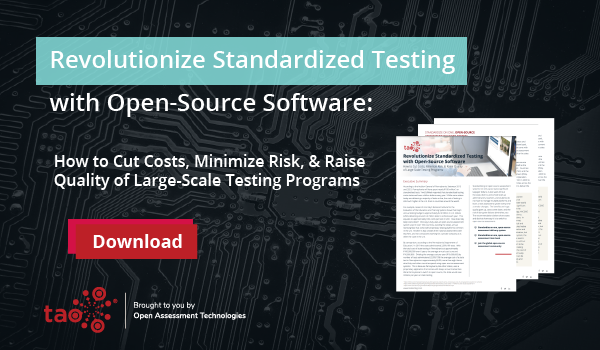The following post is an abstract from our recent white paper with Dale Cornelius, the founding chair of IMS Global Learning’s Assessment Innovation Leadership Network. Read on below to learn more about the benefits of standardizing testing using an open source assessment system like TAO, and download the full white paper here.
Revolutionize Standardized Testing with Open-Source Software: How to Cut Costs, Minimize Risk, & Raise Quality of Large-Scale Testing Programs
According to the Auditor General of Pennsylvania, “between 2015 and 2021, Pennsylvania will have spent nearly $100 million,” on standardized tests. And, EdWeek reported that standardized testing costs states well over a billion dollars every year. While some states today are delivering a majority of tests online, the cost of testing is still much higher in the U.S. than in countries around the world.
For example, research into Italy’s National Institute for the Evaluation of the Education and Training System shows that Italy’s annual testing budget is approximately $2.6 Million in U.S. dollars (USD), delivering around 4.2 million tests to schools each year. This equates to approximately 0.64 cents per test in USD.
How does Italy keep costs down? One way is Italy uses an open-source assessment system used in over 100 countries, avoiding the steep, annual licensing fees that come with proprietary testing platforms common in the U.S. Another is Italy creates their national assessments with teachers, and not consultants working for a private company as is often the case in the U.S.
By comparison, according to the Pennsylvania Department of Education, in 2019 the state administered 2,099,199 tests. With the total cost of state testing in Pennsylvania at approximately $100,000,000 over 6 years, the average annual cost is around $16,666,666. Dividing the average cost per year ($16,666,666) by number of tests administered (2,099,199) the average cost of a state test in Pennsylvania is approximately $8.00, more than eight items what Italy and other countries spend using open-source assessment systems. This is because Pennsylvania, like other states, uses a proprietary application that comes with steep, annual license fees. Were Pennsylvania to switch to open source, the state would save millions per year on state testing.
Standardizing on open-source assessment systems not only saves states significant taxpayer dollars, it also saves time at the state, district, and school levels as administrators, teachers, and students do not have to manage multiple platforms and learn a new assessment system every time a vendor changes. The benefits are huge: quality goes up, costs come down, and the risk of disruptive failures diminishes, too. The recommendations below show states and districts how easy it is to switch to open-source assessment:
- Standardize on one, open-source assessment delivery system
- Standardize on one, open-source assessment item bank
- Join the global open-source assessment community
—-
Want to keep reading? Download the white paper to learn more about the recommendations we’re making for states and districts considering moving to an open source assessment solution, and the benefits that come with it.
Get in touch with us today to find out just how easy it is to make the switch.

